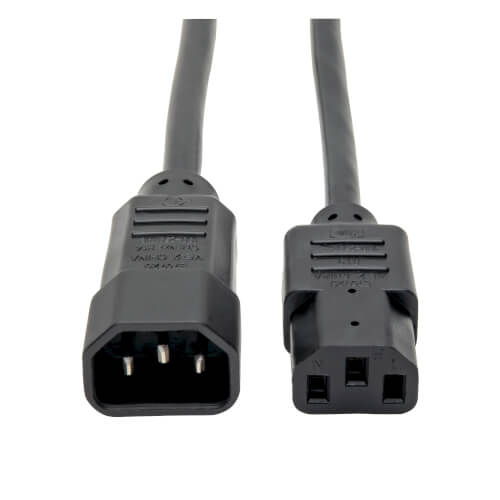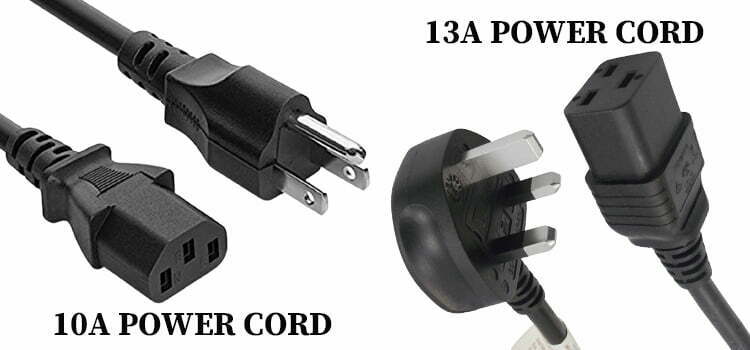Last Updated on November 1, 2022 by Tech Questions
There is a big debate when it comes to 10A vs 13A power cords. People are constantly arguing about which one is better and which one should be used. Here is a breakdown of the two types of power cords so you can decide for yourself which one is best.
The 10A power cord is the most common type of power cord. It is typically used for small appliances and electronic devices. The 10A cord is also the cheapest option, making it a popular choice for many people.
The 13A power cord is slightly more expensive than the 10A cord but it offers more features. The 13A cord can be used for larger appliances and electronic devices. It also has a built-in circuit breaker that protects against overloading and overheating.
The difference between a 10A and 13A power cord is the amount of current that can flow through them. The 10A cord is only rated for 10 amps, while the 13A cord can handle up to 13 amps. This means that the 13A cord can provide more power to your devices than the 10A cord.
If you have devices that require a lot of power, or if you plan on using them for long periods of time, then you should use the 13A cord.
PC’s original power cable rated 13A/125V, can a 10A/125V cable be used instead?
Can I Use 13A Plug for 10A Appliance?
There are different types of plugs and sockets, each designed for a specific purpose. The most common type of socket in the UK is the 13A socket, which is used for general household appliances. However, some appliances require a higher or lower current rating and so require a different type of socket.
For example, an electric hob requires a 32A socket and an electric shower requires a 45A socket. So, can you use a 13A plug for a 10A appliance? The answer is yes, as long as the appliance doesn’t draw more than 10 amps of power.
If it does, then the fuse in the plug will blow and the appliance won’t work. It’s always best to check the current rating of your appliance and make sure you’re using the right type of plug and socket.
What Does 10A Mean on a Power Cord?
Most electronic devices that use a power cord will have the amperage rating printed on the cord. The amperage rating is how many amps can flow through the cord safely. For example, if a device uses a 10-amp power cord, that means that up to 10 amps can flow through the cord and into the device.
The vast majority of common household appliances will use a power cord that is rated for 10 or 15 amps. Some larger appliances, such as air conditioners, may use a 20-amp power cord. Amps are a measure of electrical current, which is the flow of electrons through an electrical conductor.
The higher the number of amps, the more electrons are flowing through the conductor. Power cords are made from heavy gauge wire in order to handle high amp ratings without overheating. When plugging in an appliance, it is important to make sure that the power cord amperage rating is equal to or greater than the amperage rating of the appliance.
If not, there is a risk of damaging the appliance or causing an electrical fire.
What Does 10A 125V Mean?
When shopping for extension cords, you may have noticed that some of them are labeled 10A 125V and others are labeled 15A 125V. So, what’s the difference? The “10A” and “15A” refer to the amperage rating of the cord.
The amperage rating is the maximum amount of current that can flow through the cord without damaging it. In general, extension cords with a higher amperage rating will be able to handle more power and will be better suited for higher-draw devices such as power tools. The “125V” refers to the voltage rating of the cord.
This is the maximum amount of voltage that can safely flow through the cord. In general, extension cords with a higher voltage rating will be able to handle more power and will be better suited for high-voltage devices such as RVs or generators. So, if you need an extension cord for a high-power device such as a power tool, you’ll want to look for one with a high amperage rating (15A or higher).
If you need an extension cord for a high-voltage device such as an RV or generator, you’ll want to look for one with a high voltage rating (125V or higher).
What Gauge is a 10 Amp Power Cord?
Most household appliances are rated for 10 amps, so a 10 amp power cord is the standard gauge used for these types of devices. The thicker the gauge, the more electricity it can carry and the less voltage drop there will be.

Can I Use 13A Fuse in 10A Plug?
Most people believe that a 13A fuse can be used in a 10A plug, but this is not the case. While it may seem like a minor difference, the amp rating of a fuse corresponds to the amount of current that it can safely handle. Using a 13A fuse in a 10A plug would allow too much current to flow through the circuit, which could cause damage to your appliances or even start a fire.
So if you need to replace a 10A fuse, make sure to use one with the same amp rating.
Is a 10 Amp Extension Cord Enough?
As anyone who has ever used one knows, extension cords are incredibly useful tools. They allow us to plug in our devices and appliances without having to be tethered to a wall outlet. But with so many different types and sizes of extension cords on the market, it can be tough to know which one is right for your needs.
In this article, we’ll help you understand the difference between amperage and gauge, and whether or not a 10 amp extension cord is enough for your needs. Amperage is a measure of the electrical current flowing through a conductor. The higher the amperage, the greater the flow of electrons and the more powerful the device or appliance.
Most extension cords are rated for either 10 amps or 15 amps. A 10 amp cord is suitable for small appliances like lamps, coffee makers, and portable fans. A 15 amp cord can handle larger devices like space heaters and power tools.
Gauge refers to the thickness of the conductor wire inside an extension cord. The thicker the wire, the better it will be at carrying electricity over long distances without losing power. A lower gauge number (like 12 or 14) indicates thicker wire while a higher gauge number (like 16 or 18) indicates thinner wire.
In general, you’ll want to use a lower gauge number for longer extension cords and a higher gauge number for shorter ones. So now that you know what amp rating and gauge mean, let’s answer our original question: Is a 10 Amp Extension Cord Enough? For most small appliances like lamps and coffee makers, yes – a 10 amp cord will suffice nicely.
However, if you’re looking to use an extension cord with something larger like a space heater or power tool, you’ll need to go with at least a 15 amp cord – preferably one with thick conductor wires (a low gauge number).
How Many Watts Can a 10 Amp Extension Cord Handle?
Yes, a 10 amp extension cord can handle up to 1,200 watts.
Conclusion
A power cord is one of the most important parts of any electrical device. It is responsible for supplying power to the device and can be used to connect the device to a power source. There are two types of power cords: 10A and 13A.
Each type has its own benefits and drawbacks.
It is less expensive than the 13A cord and is able to carry less current, making it ideal for smaller devices. However, the 10A cord is not as durable as the 13A cord and can be damaged easily.
The 13A power cord is more expensive than the 10A cord but can carry more current, making it ideal for larger devices. The 13 A also has a thicker insulation which makes it more durable than the 10 A.
We are team at Tech Ques Blog, an exciting startup that provides innovative answers to big tech problems. Our unique approach to solving complex issues & constantly experimenting with new technologies. We are extremely focused in a wide range of areas, including computer hardware, software, networking, and more. Enjoyed to explain complex concepts to non-technical users.
